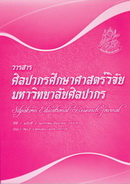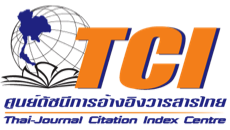การพัฒนารูปแบบการเรียนการสอนที่สร้างเสริมมโนทัศน์และการแก้ปัญหาในวิชาฟิสิกส์ ระดับชั้นมัธยมศึกษาตอนปลาย
บทคัดย่อ
บทคัดย่อ
การพัฒนารูปแบบการเรียนการสอนที่สร้างเสริมมโนทัศน์และการแก้ปัญหาในวิชาฟิสิกส์ มีการดำเนินการวิจัย 4 ระยะ คือ 1) การวิเคราะห์ข้อมูลที่ใช้ในการพัฒนารูปแบบการเรียนการสอน 2) การออกแบบและพัฒนารูปแบบการเรียนการสอน 3) การนำไปใช้โดยการนำรูปแบบฯไปทดลองใช้กับนักเรียนชั้นมัธยมศึกษาปีที่ 4 โรงเรียนสาธิตเกษตรฯ กำแพงแสน จำนวน 80 คน ทำการสุ่มห้องเรียนแบบแบ่งกลุ่ม (Cluster Random Sampling) เป็นกลุ่มควบคุมและกลุ่มทดลอง กลุ่มละ 40 คน เครื่องมือวิจัยคือแบบทดสอบการปฏิบัติมีค่าความเชื่อมั่น .99 แบบทดสอบวัดมโนทัศน์และการแก้ปัญหามีค่าความเชื่อมั่น 0.88 วิเคราะห์ข้อมูลโดยการทดสอบค่าที (t-test) แบบ Paired samples t – test และการวิเคราะห์ความแปรปรวนร่วม (Analysis of Covariance) 4) การประเมิน (Evaluation) ประกอบด้วย การประเมินระหว่างการใช้รูปแบบฯ และหลังการใช้รูปแบบการเรียนการสอน
ผลการวิจัย 1) รูปแบบการเรียนการสอนที่พัฒนามีองค์ประกอบสำคัญ 4 ประการ คือ (1) หลักการ(2) จุดมุ่งหมาย (3) กระบวนการจัดการเรียนรู้ และ (4) การวัดและประเมินผล 2) ผลการทดลองใช้รูปแบบการเรียนการสอนที่พัฒนา พบว่า นักเรียนกลุ่มทดลองมีคะแนนเฉลี่ยความเข้าใจในมโนทัศน์ทางฟิสิกส์ มีความสามารถในการแก้ปัญหา หลังการทดลองสูงกว่าก่อนการทดลอง และสูงกว่ากลุ่มควบคุมอย่างมีนัยสำคัญทางสถิติที่ระดับ.05 รูปแบบการเรียนการสอนที่พัฒนาขึ้นมีประสิทธิผล.50 และมีประสิทธิภาพ 80.37/81.04 และ 3) ผู้เชี่ยวชาญด้านหลักสูตรและการสอนฟิสิกส์ มีความเห็นว่า รูปแบบที่พัฒนาขึ้นสามารถพัฒนาความเข้าใจในมโนทัศน์ทางฟิสิกส์ และความสามารถในการแก้ปัญหา มีความเหมาะสมและสามารถนำไปใช้กับนักเรียนระดับชั้นมัธยมศึกษาตอนปลายได้
Abstract
This research aimed to develop an instructional model enhancing conceptual understanding and problems solving in the field of physics for upper secondary schools. It was conducted in 4 phrases : 1) analysis of data and information in the development of the model ; 2) design and development of the model ; 3) implementation of the model among 80 Mattayomsuksa 4 students of Kasetsart University Laboratory School in the 2nd semester of academic year 2009 and 4) evaluations of the model during and after the model implementation.
The research results were:
1) The model consisted of 4 key elements: (1) principles; (2) objectives; (3) learning management process and (4) measurement and evaluation.
2) The experimental group students had higher scores of conceptual understanding and higher ability of problem solving from the posttest than the pretest and the control group with the statistical significance level of .05.
3) The effectiveness index was .50 and the efficiency index was 80.37/81.04 which is higher than the standard criteria of 80/80.
4) The experts in curriculum and physics instruction viewed that the developed instructional model was effective, efficient and suitable to be implemented.





